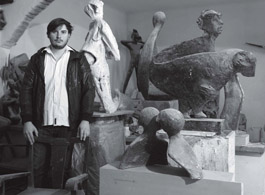
Czech Pavilion in Venice will be filled by Lang's Sleeping City
 |
| photo: Jiří Thýn |
However, according to the author, it is not a retrospective exhibition of his father's work. "His sculptures are material for me; I transform them significantly, cold-bloodedly, but at the same time with feeling," Lang told ČTK. According to him, the work of his father could be represented in a site-specific installation by the creations of practically any artist of that era.
"My interpretation of my father's work should evoke the history of our country for visitors, especially the artistic grayness of the 1950s and 1960s," said Lang.
Concerns that the installation could be too complex for viewers at first glance are rejected by the author. "I am aware of certain risks, but if the viewer is even a little perceptive, they will decipher the exhibition," Lang stated.
The selection of Dominik Lang as the representative of the contemporary art scene in the Czech Republic and Slovakia was accompanied by complications. Although Lang’s project was recommended for the Venice Biennale by a professional commission established by the National Gallery (NG), its director, Milan Knížák, did not respect the commission's decision and preferred the projects of other artists, the trio of Vasil Artamonov, Alexej Klyuykov, and Pavel Sterec. However, they refused to participate in the prestigious biennale in protest against such proceedings.
A wave of protest from artists and art historians arose against Knížák's decision. Minister of Culture Jiří Besser (for TOP 09) then decided on December 6 that Lang would go to the biennale and that the organization of the biennale and the responsibility for selecting artists would in the future be taken over by the Ministry of Culture.
"The representation at the biennale should be determined by a professional commission, not a biased artist," Besser declared, adding that the corresponding legislative change has already come into force. Thus, only the ministries of culture of the Czech Republic and Slovakia and the Slovak National Gallery will continue to be involved in the preparations for the Czech and Slovak representation at the biennale. Lang expected the twists and turns regarding his selection. "I know the current state of the NG and what opinions are held by its director. However, I do not deny that I was disappointed by the rejection."
The English translation is powered by AI tool. Switch to Czech to view the original text source.
0 comments
add comment










